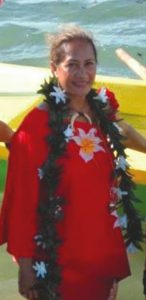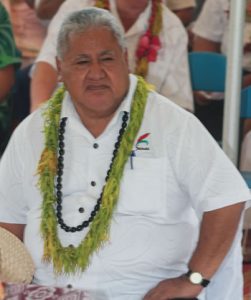Vaimasenu’u Zita Sefo Martel, Fautasi Boat Captain

Vaimasenu’u Zita Sefo Martel
MM: How did you get involved with the John Bosco Technical Centre in Apia?
Father Mosese, the previous Principal of Don Bosco Technical Centre, came to see me in October 2004 in my role as the Honorary Consul of France in Samoa. He wanted to know whether the government of France would accept a proposal from Don Bosco for any financial assistance as the school really needed extra funding to run its vocational trade projects. I told Father Mosese that it was unlikely that any straight-out funding assistance will be given to the school but that I will find some way of helping him and his school.
I thought of offering them the use of the Si’usega parish fautasi boat of which I was the guardian And furthermore, the colours of the Segavao bird and boat are green and yellow. The colours of the Don Bosco Technical Centre uniform are green and yellow.
I went to the Don Bosco Technical Centre at Alafua, found Father Mosese and told him that instead of straight out funding from the government of France, “How do you feel about being the first ever school to compete in the history of fautasi racing in Samoa, to win races and no longer be called a school of rejects, coached and skippered by the Honorary Consul of France?”. Father Mosese was speechless...and fortunately said YES! In June 2005, Segavao Don Bosco’s maiden race, we placed 3rd. In September 2005, we placed 2nd. In April 2006 (Flag Day American Samoa), we came 1st.
There are two fautasi longboat races every year – the June Independence Race and the September Teuila Festival Race – with prize monies of $22,000, $19,000, $17,000 for the top three places. We have won many races and have never placed below 2nd place after our first year in the sport.
Internationally, we have represented Samoa twice when American Samoa invited us to compete on their flag day celebrations in April 2006 and we won there and made history. American Samoa invited us back in 2010 for their flag day celebrations and we came 2nd. A challenge race was then issued in 2010 when the new high tech carbon fibre longboat from American Samoa with sliding seats which cost $400,000 US dollars was brought to Samoa to race against us in the 2010 June Independence Race using cleaver carbon oars. Our Segavao II longboat built in 2002 and made of wood cost our church $50,000 Samoan Tala (US$15,000 dollars). We won that 5 mile race for Samoa, and again made history.
MM: As well as being coach and skipper, you supervised the building of the latest fautasi(long boat)? Where?
Our 3rd longboat, the Segavao III, like our 2nd longboat the Segavao II, was our church parish’s show of support to our Chairman who is also the Prime Minister of Samoa. I designed the new Segavao III longboat, for the celebration of our 50th Anniversary of Independence. My design was then drafted by an architect church member and built by another church member who is a house builder. I also supervised the building of the longboat.
Instead of sticking to the European ‘lighter’ design (lighters are rowing boats that came off the trading copra ships in the early 1900s) which all the longboats in Samoa are fashioned after, I took the design back to our traditional outrigger ‘paopao’ canoe, as I felt it only fitting that a fautasi or longboat built for our country’s 50th anniversary of Independence be of a Samoan-Polynesian voyaging design. And this beautiful vessel was blessed on my mother’s 81st birthday on the 14th May 2012, which I felt was truly a blessing. It is tough being the only woman skipper in a traditional sport for men and my mother, Vaelenoatia Letalu Tago Sefo, who lives in Auckland became my biggest supporter and is my role model for strength, independence, grit and Samoan grace.

Samoa’s prime minister, Tuila’epa Lupesoliai Sa’ilele Malielegaoi
MM: How long were you training with these 42 rowers?
We trained for 3 months and in the last 4 weeks before the race, we go into training camp.
MM: What place does the long-boat have in Samoan culture?
Longboats are western vessels which started from lighters or rowing boats that were put down from the copra ships in the early 1900s. The mother ship couldn’t fit through the reef, so lighters rowed ashore to pick up the dried copra from the coastal villages around the Samoan islands.
Samoans, being voyaging people, lengthened the lighter to take more cargo and passengers and became the passenger vessels between villages and islands. Sails were also rigged onto the longboats to catch a good wind and give the crew a rest from rowing.
Now the length of a longboat, used solely for racing, measures anywhere between 85 to 100 feet. Longboat racing pulls together whole villages – the colours, the drum beats, the prowess of the crew and the skills of the skipper are called into play to protect the honour of a village or district. In Samoan culture, voyaging and navigation is very much a part of our traditions and adapting a western boat to suit our circumstances was a natural fit.
MM: Are you the only woman to skipper and train a fautasi crew of men?
Yes I am. I made my debut as Skipper and Coach of our Lady of the Rosary longboat, Segavao I in September 2001. Fautasi or longboat racing is a fiercely contested sport in Samoa and American Samoa and has no women rowers or skippers. It’s been 12 years of being the only woman in the sport. There will come a day when another will step in to the arena of “fa’agatama i le tai” or the sport of men on the ocean.
MM. What does your winning mantra ‘One Beat’ mean for you and the crew?
It means everything to me, to my crew, to Don Bosco school and to the parents and supporters! One Beat was coined by my 1st Don Bosco crew of 2005. After weeks of rowing training on the ocean in the hot sun, in frustration, I told my crew to stop rowing and to be absolutely still and quiet on the fautasi. Not a sound could be heard while we drifted on the ocean.

“There are 43 of you rowing. We’ve been at it for 4 weeks and you still haven’t given me what I want. What is the one phrase I’ve been saying consistently for the past 4 weeks of rowing?”
One student said, “Captain - Tasi le pao”.
“Who can give me the translation in English?”
Another student said, “Captain – One beat”
When 43 oars fall together into the ocean as one. When 43 oars pull on the gunnel of the boat as one. When 43 hearts beat as one. When 43 rowers row as one to the beat of the drum, when you are one with the currents of the ocean, and the command of the Captain. One beat.
From this seed, we have taken our ocean going mantra to also mean that we row as one with ourselves, our team, our school, our parents, our family, our village, our church, our country and Jesus. It has become a beautiful prayer and cloak that the students don when they take up their oars and get ready for a race. They go to a race knowing that they are not doing it just for themselves but for their school, their parents, their families, their villages, their churches, their country and for Jesus who is our 43rd rower. And by taking ownership of their actions, they have made Don Bosco Technical Centre a school with a proud history of ‘can do’ students and no longer labled a “school of rejects”.
MM: What effect has the win had on the Bosco Technical Institute staff and students?
The 50th Anniversary of Independence longboat race, 5 June 2012, was a proud historical win for all of us.
As the Prime Minister told us in his speech to the school, “The Fautasi Race is the traditional grand finale of any festival or celebration in Samoa. No one will remember who won the Independence race of 2007 or 2009. Everyone will remember who won the 50th Independence Race of 2012. We all know who won the 1st Independence Race of 1962. Will you be the ones to win the 50th? Go and write your names in the history books of this country”.
It has raised Don Bosco Technical Centre to another level.
On Saturday, 2nd June 2012, on our new longboat the Segavao III, we were honoured to host the following VIP guests for a symbolical impromptu ride around Apia harbour :
Sir Jerry Mateparae, the Rt Hon. Governor General of NZ
His Excellency Nick Hurley and Mrs Christine Hurley, the NZ High Commissioner in Samoa
His Excellency Francis Etienne and Mme. Jane Etienne, my Ambassador of France to Samoa based in Wellington
Sister Monika Tofilau, Principal of Don Bosco Technical Centre.
I thank their Excellencies for gracing our longboat with their presence and acknowledge with gratitude what it meant to my crew.
Zita Sefo Martel received her matai title Vaimasenu’u in 1992 in Amaile village, Aleipata, She is married to Francois Martel and they have four boys ranging from 21 to 8 years old.
 Entries(RSS)
Entries(RSS)